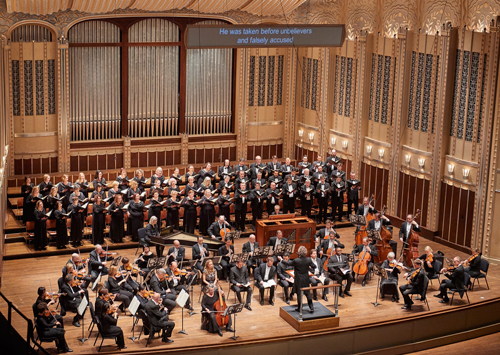by Daniel Hathaway

Though the mid-sized chorus of 56 singers and orchestra of 34 players far exceeded the forces Bach had to work with in Leipzig on Good Friday afternoon of 1724, the ensemble was small and malleable enough to allow the conductor to draw a variety of expressive nuances from the performers. Leading the performance barehanded, Welser-Möst created dramatic dynamic swells and ebbs in the opening chorus (“Herr, unser Herrscher”), and subtly massaged tempos, especially in the final chorus (“Ruht wohl.”)
The Cleveland Orchestra Chamber Chorus, prepared by Robert Porco, responded to every gesture from the podium. During the two-hour-long Passion story, they assumed the roles of theologians in the opening chorus, the Disciples and the crowd in the Gospel narrative, the Leipzig congregation in the chorales, and a grieving community in the final chorus. They had the last word in “Ach Herr, lass dein lieb Engelein,” that affecting hymn that ends the piece with an almost Mahlerian, childlike prayer.
Their diction was crisp and their ensemble tight even in challenging moments like the “Wohin’s” in the bass aria “Eilt.” And the singers achieved a wide range of emotional colors from the seething shouts of “Kreuzige, kreuzige!” to the hushed hymn overlay to the aria “Mein teurer Heiland.”
Tenor Maximilian Schmitt sang the Evangelist with ease and polish and a similarly broad range of emotions — from hair-raising pronouncements to muted asides. Andrew Foster-Williams and Michael Sumuel dispatched the roles of Christus and Pilate with commanding skill. Small parts in the narrative were nicely taken by chorus members Anna E. White (maid), Ted Rodenborn (servant), and Francisco X. Prado (Peter).
When the action paused for reflection, the aria soloists took the spotlight. Soprano Lauren Snouffer was clear and lithe in “Ich folge dir gleichfalls” (with obbligato by the flutes) and hauntingly poignant in “Zerfleiße, mein Herze,” (supported by flutist Joshua Smith, English hornist Robert Walters, and bassoonist John Clouser).
Countertenor Iestyn Davies made compelling moments out of “Von den stricken” and “Es ist vollbracht,” accompanied in the former by oboes and bassoon, and in the latter by violist da gamba Ann Marie Morgan. Foster-Williams stepped out of his role as Jesus for two bass arias, the first harried and urgent (“Eilt”), the second (“Mein teurer Heiland”) strikingly upbeat considering that Jesus has just expired on the cross.

An odd setup placed continuo cellist Mark Kosower and his colleagues at the chamber organ and harpsichord upstage between the winds and chorus, and later, located the gambist at the very front of the stage. That seemed to pose few ensemble problems for these excellent musicians, but it did affect some balances. In “Betrachte, meine Seel,” originally written for violas d’amore with lute obbligato and later replaced by muted violins and organ, the organ part was nearly inaudible. In the following aria, “Erwäge,” the gamba line overbalanced the violins.
In Leipzig, an hour-long sermon would have separated the short first and longer second part of the St. John. In modern times, that’s where an intermission usually intervenes and disrupts the dramatic flow. It would have been interesting to have heard a straight-through performance last Thursday, avoiding the awkwardness of applause in the middle of such a gripping musical drama. Alter all, Bach’s congregation managed to sit for three hours on benches — in an unheated church.
Photos by Roger Mastroianni courtesy of The Cleveland Orchestra.
Published on ClevelandClassical.com March 11, 2017.
Click here for a printable copy of this article



